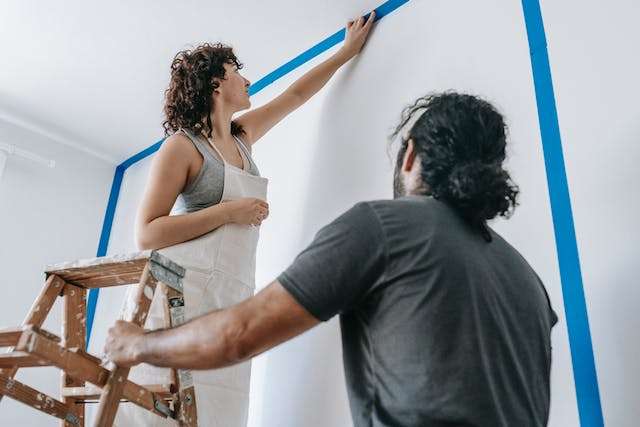The Art of Perfecting Drywall Finishing

Are you ready to turn your walls into works of art? Look no further than the art of drywall finishing. It’s the crucial step that transforms rough, raw walls into smooth, flawless surfaces. Let’s dive into the world of drywall finishing and discover the tips, techniques, and secrets to achieving a flawless finish.

Understanding Drywall Finishing
Are you ready to unlock the secrets of transforming rough, raw walls into smooth, flawless surfaces? The art of drywall finishing is the key to achieving this transformation. It’s the crucial step in creating walls that are not only structurally sound but also visually stunning. Let’s explore the purpose of drywall finishing and the different types of finishes that can elevate the look of any space.
The Purpose of Drywall Finishing
So, you might be wondering, “What’s the whole deal with drywall finishing?” Well, the purpose is pretty simple but oh-so important. It’s the art of turning those rough, bumpy walls into something smooth, flawless, and ready for a fresh coat of paint. Think of it as the magic touch that transforms your walls from looking like they just survived a storm into picture-perfect surfaces that are ready to showcase your creativity and style. In other words, drywall finishing sets the stage for a stunning interior look, whether it’s in your cozy home or a dazzling commercial space. It’s the essential step that takes your walls from average to extraordinary.
Types of Drywall Finishes
When it comes to finishing your walls, you have a variety of options to choose from to achieve the perfect look. Textured finishes such as orange peel, knockdown, or popcorn add dimension and can hide imperfections in the wall. For a more traditional and smooth appearance, smooth finishes offer a sleek and elegant look. Venetian plaster is another option, providing a luxurious and polished aesthetic. Whether you prefer a modern, rustic, or classic style, the type of finish you choose can significantly impact the overall ambiance of your space.
Preparing for a Flawless Finish
Before diving into the world of creating smooth, flawless walls, it’s crucial to prepare properly. This involves gathering the necessary tools and materials and employing effective surface preparation techniques. By ensuring that you have everything you need and the surface is ready, you’re setting the stage for a successful drywall project. Let’s explore the essential steps to take before diving into the art of creating seamless walls.
Gathering the Necessary Tools and Materials
When it comes to creating beautifully smooth walls, having the right tools and materials is crucial. You’ll need items like a taping knife, mud pan, sanding sponge, and joint compound. Remember, having everything you need at your fingertips will make the process flow more smoothly. So, be sure to gather all the tools and materials required to achieve that flawless finish!
Surface Preparation Techniques
Before diving into the exciting world of transforming your walls, it’s crucial to prepare the surface properly. Here are a few surface preparation techniques to ensure your walls are in prime condition for the transformation:
- Cleaning: Begin by thoroughly cleaning the walls to remove any dirt, dust, or grease that might hinder the finishing process.
- Repairing Imperfections: Fill any cracks or holes with spackle or joint compound and sand them smooth for a seamless finish.
Remember, the key to a flawless finish lies in the preparation of the canvas, in this case, your walls.
Mastering Techniques for Smooth, Flawless Walls
Ready to take your walls from rough and raw to smooth and flawless? Mastering drywall finishing techniques is the key to achieving a perfect surface. From taping and mudding seam joints to sanding and smoothing surfaces, these techniques will elevate your walls to a whole new level of perfection.
Taping and Mudding Seam Joints
When it comes to achieving a flawless finish on your walls, taping and mudding seam joints are essential steps in the process. Taping involves applying drywall tape over the joints to create a seamless surface, while mudding refers to the process of applying joint compound over the tape to fill and smooth out the seams. By using the right techniques and tools, such as a taping knife and sandpaper, you can ensure that the seam joints blend seamlessly into the drywall, resulting in a smooth, flawless surface ready for painting or finishing.
Sanding and Smoothing Surfaces
When it comes to transforming rough and uneven walls into sleek and flawless ones, sanding and smoothing surfaces play a pivotal role. It’s like the fine-tuning step that takes your walls from good to great. By utilizing high-quality sandpaper and employing proper sanding techniques, you can achieve a smooth and uniform surface that’s ready for painting or wallpapering. Remember, patience and attention to detail are key when it comes to achieving that perfect, polished finish.
Remember, sanding and smoothing surfaces may require multiple rounds of sanding with different grits of sandpaper to achieve the desired smoothness. Additionally, using a sanding block or pole sander can help maintain an even surface across the entire wall.
Conclusion
With the right tools, techniques, and a touch of creativity, drywall finishing can transform your space in ways you never thought possible. Bring smooth, flawless walls to life and add a touch of artistry to your home or project with the mastery of drywall finishing.

